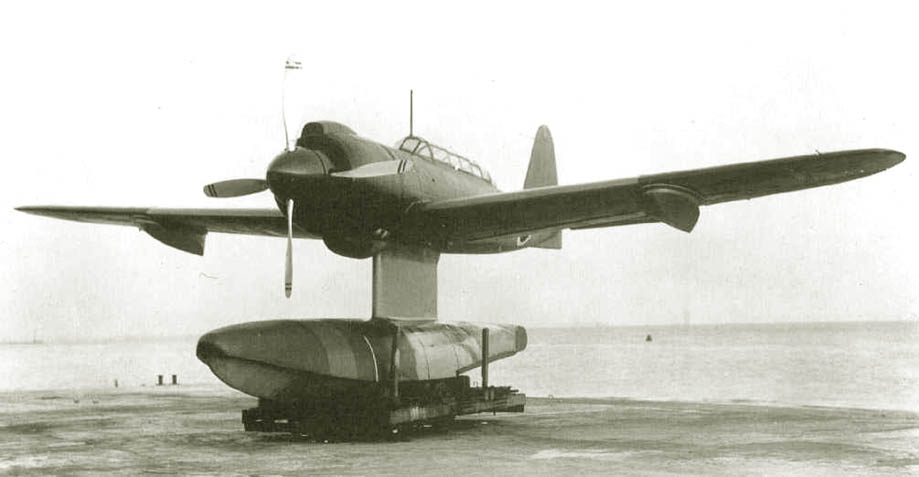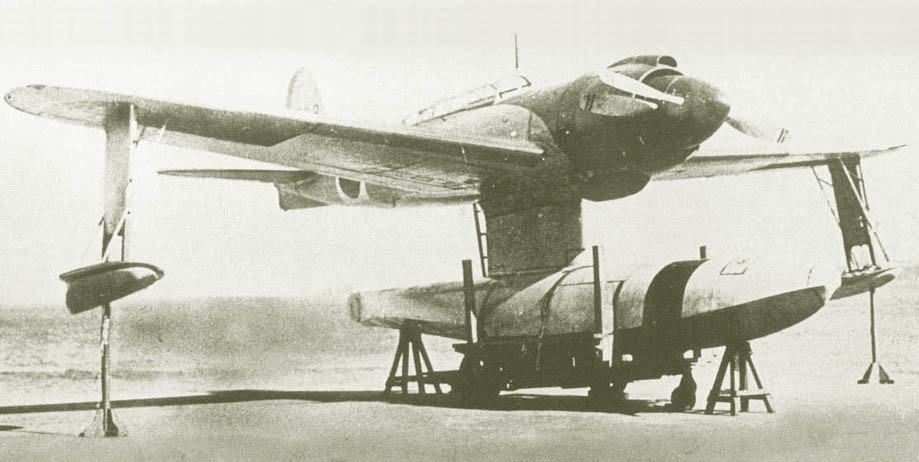|
E15K "Shiun"
 |
- Reconnaissance Seaplane
- First flight: 1941
- Kawanishi
|
In 1939, the Imperial Japanese Navy commissioned the Kawanishi Aircraft Company to develop a two-seat high-speed reconnaissance seaplane that had sufficient speed to avoid interception by ground fighters. It was planned to equip a new class of cruisers with new seaplanes - flagships for groups of submarines in order to find targets for their attacks. The first such new cruiser, Ōyodo, was also ordered in 1939.
Kawanishi has developed a single-engine seaplane powered by a 1460 hp Mitsubishi MK4D Kasei 14-cylinder radial engine. (1090 kW) with a drive of two two-blade counter-rotating propellers, first produced in Japan and designed to eliminate the reactive torque, which significantly complicates the takeoff and landing of seaplanes. To achieve high speeds, a laminar wing profile was chosen, developed by a professor at the University of Tokyo Ichiro Tani. The seaplane had one main float under the fuselage and two stabilizing floats under the wing. The stabilizing floats were designed to retract into the wing, and the central float had to be able to be dropped in case of an emergency, giving a sufficient, about 50 knots (90 km / h), increase in speed to evade enemy fighters.
The presence of many new developments greatly delayed the implementation of the project, the first prototype, which received in the short designation system of the Navy - E15K1, made its first flight on December 5, 1941. Five more prototypes were produced in 1941-42. Problems arose with retractable stabilizing floats, which led to several accidents when the floats were not released for landing, and they had to be abandoned, having been fixed in the released position.
The results of the factory flight tests were satisfactory: the aircraft demonstrated good aerobatic qualities. However, there were problems with the control of the pitch of the coaxial screws rotating in opposite directions.
In general, the aircraft had an all-metal structure, with the exception of the linen covering of the ailerons and rudders, to improve the longitudinal stability the aircraft was equipped with an additional ventral keel.
In this form, the K-10 was adopted as "High-speed reconnaissance seaplane Type 2" Siyun "(Purple cloud) Model 11" (E15K1 Model 11). At the beginning of 1944, a batch of five vehicles, along with a prototype, were sent to the island of Palau for testing in combat conditions. Soon all the vehicles were shot down by Allied fighters. The system of dropping the central float did not work in flight, which is why the E15K1 could not use its main trump card - high speed and became an easy prey for enemy fighters. An interesting idea, for the implementation of which the seaplane was developed, was not implemented. The lack of armor protection for the cockpit, the use of unprotected fuel tanks and weak defensive armament (one 7.7-mm machine gun) further exacerbated the situation.
True, the Kawanishi company began mass production of an improved version of the E15K1 Model 12. To compensate for the increased drag due to the failure to remove the stabilizing floats, it was necessary to use a more powerful Mitsubishi MK4S Kasei 24 engine with a capacity of 1825 hp. It was planned to equip a number of warships with new machines, but in February 1944, due to unsuccessful results of combat use, the serial production of E15K1 aircraft was discontinued.
|
| American code name |
Norm |
| Crew |
2 |
| Dimensions |
|---|
| Length, m |
11,59 |
| Height, m |
4.95 |
| Wing span, m |
14.00 |
| Wing area, m² |
30.0 |
| Wing loading, kg/m² |
136.7 |
| Powerplant |
|---|
| 1 × PE Mitsubishi МК4S Kasei 24, power hp |
1 × 1,850 |
| Weight, kg |
|---|
| Empty |
3,165 |
| Loaded weight |
4,100 |
| Gross weight |
4,900 |
| Performance |
|---|
| Maximum speed, km/h at H 5700 m |
468 |
| Cruising speed, km/h |
296 |
| Time to altitude 6000 m, min |
10 |
| Service ceiling, m |
9,836 |
| Service range, km |
3,373 |
| Armament |
|---|
| Machine gun type 92, 7.7 mm caliber, pcs |
1 |
| Bomb load, kg |
2 × 60 |
A total of 15 vehicles of this type were built, including 6 prototypes. Low survivability, unreliability of the power plant, the complexity of the system for dropping and cleaning the floats led to the complete failure of the project to create a seaplane capable of escaping from fighters.
 |
Drawing E15K1-1
|
 |
E15K1 with floats extended
|
Bibliography

- Japanese Aircraft of the Pacific War /Rene J.Francillion./
- Japanese float planes /Evgeny Aranov/
- Kawanishi E15K1 Shiun Reconnaissance Seaplane /Alternative history. Ivan Byakin./
- Japanese aviation /Andrey Firsov/
- Encyclopedia of Military Equipment / Aerospace Publising /
|





